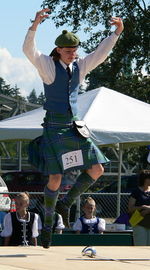CZ:Featured article/Current: Difference between revisions
imported>Anton Sweeney m (typo) |
imported>Chunbum Park No edit summary |
||
| Line 1: | Line 1: | ||
== '''[[ | == '''[[Kilt]]''' == | ||
''by [[User: | ''by [[User:James F. Perry|James F. Perry]] <small>(and [[User:Charles Sandberg|Charles Sandberg]], [[User:Chris Day|Chris Day]] and [[User:David Boven|David Boven]])</small>'' | ||
---- | ---- | ||
{{Image| | {{Image|Highland_Dance_001.jpg|right|150px|Highland dancer wearing a kilt}} | ||
'''[[ | A '''[[kilt]]''', as the term is used in this article, is a skirtlike traditional Scottish garment in its modern form as illustrated in the photo at right. In this form, the kilt can be seen at modern-day Highland games gatherings in Scotland and elsewhere throughout the world. Historical forms of the Scottish kilt have differed in several particulars (some quite substantial) from the modern-day version. | ||
The modern Scottish kilt is worn by both male and female Highland dancers, bagpipers, Highland athletes, and other performers and entertainers. Apart from these activities, it is worn almost exclusively by men at Highland Games and elsewhere. Women other than dancers and performers sometimes wear a kiltlike garment called a kilt-skirt which differs in several particulars from the kilt. | |||
The organizations which sanction and grade the competitions in Scottish highland dancing and bagpiping all have rules governing acceptable attire for the competitors. These rules specify that kilts are to be worn (except that in the national dances, the female competitors will be wearing the Aboyne dress). The word ''kilt'' as used in this article refers to those garments as typically seen in such competitions.<ref>[http://www.bcpipers.org/rules.html Rules of the British Columbia Pipers Association] - in which "acceptable highland dress" for solo pipers and pipe bands is specified</ref> <ref>[http://www.margshighlanddancewear.com/sobhd.htm Costuming regulations of the Scottish Official Board of Highland Dancing]</ref> | |||
The | |||
''[[ | ===General description of a kilt=== | ||
The kilt, as referenced above, is a tailored garment which is wrapped around the wearer's body at the waist, hanging down encircling and covering the upper part of the legs above the knees. The fabric is cut so that it is open along a line from the waist to the lower edge (the ''selvedge'' on a kilt) with the opening being secured by means of straps and buckles. | |||
The two ends of the kilt fabric overlap considerably to form what are called aprons. These aprons are positioned in the front while the remaining length of the fabric is pleated. | |||
In addition, the kilt exhibits certain peculiarites of design, construction, and convention which differentiate it from other garments fitting the above description. | |||
''[[Kilt|.... (read more)]]'' | |||
{| class="wikitable collapsible collapsed" style="width: 90%; float: center; margin: 0.5em 1em 0.8em 0px;" | {| class="wikitable collapsible collapsed" style="width: 90%; float: center; margin: 0.5em 1em 0.8em 0px;" | ||
Revision as of 18:44, 8 December 2011
Kilt
by James F. Perry (and Charles Sandberg, Chris Day and David Boven)
A kilt, as the term is used in this article, is a skirtlike traditional Scottish garment in its modern form as illustrated in the photo at right. In this form, the kilt can be seen at modern-day Highland games gatherings in Scotland and elsewhere throughout the world. Historical forms of the Scottish kilt have differed in several particulars (some quite substantial) from the modern-day version.
The modern Scottish kilt is worn by both male and female Highland dancers, bagpipers, Highland athletes, and other performers and entertainers. Apart from these activities, it is worn almost exclusively by men at Highland Games and elsewhere. Women other than dancers and performers sometimes wear a kiltlike garment called a kilt-skirt which differs in several particulars from the kilt.
The organizations which sanction and grade the competitions in Scottish highland dancing and bagpiping all have rules governing acceptable attire for the competitors. These rules specify that kilts are to be worn (except that in the national dances, the female competitors will be wearing the Aboyne dress). The word kilt as used in this article refers to those garments as typically seen in such competitions.[1] [2]
General description of a kilt
The kilt, as referenced above, is a tailored garment which is wrapped around the wearer's body at the waist, hanging down encircling and covering the upper part of the legs above the knees. The fabric is cut so that it is open along a line from the waist to the lower edge (the selvedge on a kilt) with the opening being secured by means of straps and buckles.
The two ends of the kilt fabric overlap considerably to form what are called aprons. These aprons are positioned in the front while the remaining length of the fabric is pleated.
In addition, the kilt exhibits certain peculiarites of design, construction, and convention which differentiate it from other garments fitting the above description.
| notes |
|---|
|
